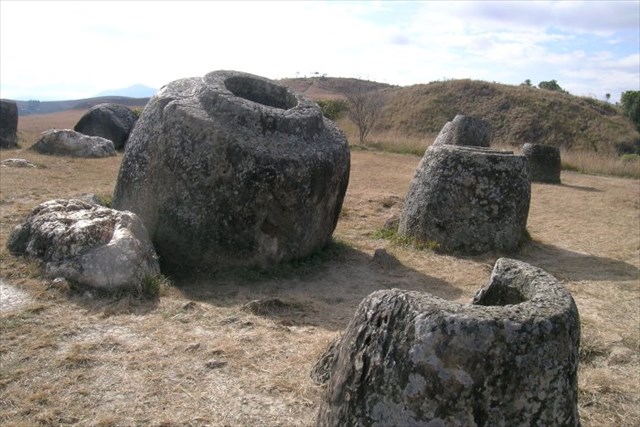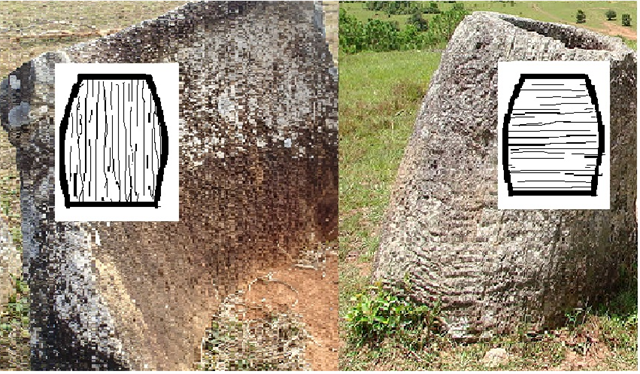Plain of Jars - GE11 EarthCache
-
Difficulty:
-

-
Terrain:
-

Size:  (not chosen)
(not chosen)
Please note Use of geocaching.com services is subject to the terms and conditions
in our disclaimer.
This cache is located on archeological site 1 on Plain of jars. It is magnificant place with stone jars varying in size from 0,3-3m, weight from 0.1-30 tons.
On the site I learned a lot of information from local guide. Some sound reasonable, some were a bit strange and suspicious . I was fascinated by this archeological site and decided to find some information about it and share it with you.
The Plain of Jars
The jars were probably made 1500-2500 years ago. We know nothing about this civilization, as it disappeared around 500AD. New settlement is here recorded for about 1000 years. Local legends that these jars were used to store rice whiskey or water, but research indicates that these jars were part of funerary rites. Excavation by Lao and Japanese archaeologists has supported this interpretation with the discovery of human remains, burial goods and ceramics around the stone jars. Most of the jars have lip rims, so it is presumed that all stone jars supported lids, although few stone lids have been found.
There are currently 60 known jar sites with over 2000 jars. The sites are not only on central plain, but in the hills around and chain of mountains near the Vietnam border. Unfortunately only three sites are accessible for tourist, as all the area is still full of cluster bombs and very danger.

Jar geology
The jars were made from five rock types – sandstone (41 sites), granite (7 sites), conglomerate (6 sites), limestone (2 sites) , breccia (1 site). On one site were found not finished jars from very strong andesite – the material was probably too strong for iron tools. It shows that people made jars from any good material. Near the sites can be found old quarries, however on many places the origin of material is unknown.
The jars on this archeological site are made from sandstone only, so we focus on it. The sandstone is from massive sandstones, deposit in Jurassic (180-200Ma). Where the jars exhibit bedding, it is usually vertical or sub-vertical orientation, but in some cases horizontal orientation too. The decision how to carve the jar was probably done by size of rock blocks available, but the orientation of bedding too. Only one unfinished jar with oblique bedding was found - it was broken during creation.

The cave on the site
Coordinates of earthcache brings you in front of the cave. This is natural limestone cave, so the sandstone jars could not be made from its material. Both stones look very similar, but the proof is very easy – if you drop Chlorid Acid on Limestone, it starts to fizz due to chemical reaction.
In the cave you can found holes in the roof. The holes worked as chimney as the cave served as a crematory in ancient time. During the secret war the cave was used as a shelter and many wounded people died there. Local people are making there the stones towers to remember dead relatives – so please be respectful there.
About bedding
Bedding can be seen sometimes on jars. It can be seen in limestone cave too, but it is completely different. How it happen? How is it possible?
We can see bedding usually in sedimentary rocks. The rocks are formed by deposition of material in layers. The deposition can take milions of years and each layer is a bit different due to different conditions or material of sediment. In the beginning all layers were horizontal, however due to the movement of tectonic plates and structural deformation of the Earth’s crust their position and orientation can change – so the layers can have any inclination. Sometimes the bedding is not visible, as the sediment was homogenous and the result is very compact rock. Sometimes you can see that rock split in the direction of layers, as some layers are soft and crumble due to weathering.
The sandstone quarry
I wanted to know from where the sandstone blocks were transported to this place. Unfortunetely our guide or other people did not know it and I did not find any information about it in literature too. If any other cacher find some info about it, I will be pleased to add it to this listing - or better make a waypoint to this cache.
Questions /send me your answers before log/ :
1) Can you see some bedding on the jars?
2) Can you see some layers or bedding in the cave?
3) What color is the limestone?
4) Why do you think the jars on this site were not made from the limestone?
5) Optional: Nice picture is always welcome
ລາຍລະອຽດຂອງ Geocache
ຖານຄວາມຈໍາ ນີ້ແມ່ນຕັ້ງຢູ່ ໃນເວັບໄຊຂອງ ບູຮານຄະດີ ທີ 1 ກ່ຽວກັບ ທົ່ງໄຫຫີນ . ມັນເປັນ ສະຖານທີ່ ທີ່ດີເລີດ ທີ່ມີ jars ກ້ອນຫີນ ທີ່ແຕກຕ່າງກັນ ໃນ ຂະຫນາດ ຈາກ 0,3 , 3m , ນ້ໍາ ຈາກ 0.1-30 ໂຕນ .
ຢູ່ໃນເວັບໄຊ ທີ່ຂ້າພະເຈົ້າ ໄດ້ຮຽນຮູ້ ຢ່າງຫຼາຍຂອງການ ຂໍ້ມູນຂ່າວສານ ຈາກ ຄູ່ມື ຂອງທ້ອງຖິ່ນ . ບາງ ສຽງ ສົມເຫດສົມຜົນ , ບາງຄົນ ໄດ້ ຊ່ວຍ strange ແລະ ສົງໃສ. ຂ້າພະເຈົ້າ ໄດ້ fascinated ໂດຍ ເວັບໄຊ ບູຮານຄະດີ ນີ້ ແລະ ໄດ້ຕັດສິນໃຈ ທີ່ຈະ ຊອກຫາ ຂໍ້ມູນຂ່າວສານ ກ່ຽວກັບມັນບາງ ແລະ ແບ່ງປັນມັນກັບ ທ່ານ .
ການ ທົ່ງໄຫຫີນ
ການ ໄດ້ ອາດຈະເປັນ 1500-2500 ປີກ່ອນຫນ້ານີ້ . ພວກເຮົາຮູ້ວ່າ ບໍ່ມີຫຍັງ ກ່ຽວກັບ ພົນລະເມືອງນີ້ ໄດ້ຍ້ອນວ່າມັນ ຫາຍໄປ ປະມານ 500AD . ການຕັ້ງຖິ່ນຖານ ໃຫມ່ ຖືກບັນທຶກລົງ ໃນທີ່ນີ້ ສໍາລັບການ ປະມານ 1000 ປີ . ນິທານ ທ້ອງຖິ່ນ ທີ່ jars ເຫຼົ່ານີ້ໄດ້ຖືກ ນໍາໃຊ້ເພື່ອ ເກັບຮັກສາ ເຫຼົ້າຂາວ ຫຼື ນ້ໍາ , ແຕ່ການຄົ້ນຄວ້າ ຊີ້ໃຫ້ເຫັນວ່າ jars ເຫຼົ່ານີ້ແມ່ນ ສ່ວນຫນຶ່ງຂອງ. ການຂຸດຄົ້ນ ໂດຍ ສປປລາວ ແລະ ໂບຮານຄະດີ ພາສາຍີ່ປຸ່ນ ໄດ້ ສະຫນັບສະຫນູນ ການຕີລາຄາ ນີ້ ມີການຄົ້ນພົບ ຂອງ ຊາກ ມະນຸດ , ສິນຄ້າ ໄດ້ຖືກຝັງໄວ້ ແລະ ປະມານ jars ກ້ອນຫີນດັ່ງກ່າວ . ສ່ວນໃຫຍ່ຂອງ ມີ ຈັກ, ປາກ , ສະນັ້ນມັນ ແມ່ນຖື ວ່າ jars ກ້ອນຫີນ ທັງຫມົດ ສະຫນັບສະຫນູນ, ເຖິງແມ່ນວ່າ lids ແກນ ບໍ່ພໍເທົ່າໃດ ໄດ້ຖືກພົບເຫັນ .
ປະຈຸບັນມີ 60 ສະຖານທີ່ ເປັນທີ່ຮູ້ຈັກ ກະປ໋ອງ ທີ່ມີ ໃນໄລຍະ ປີ 2000 . ສະຖານທີ່ ແມ່ນບໍ່ພຽງແຕ່ ກ່ຽວກັບການ ສູນກາງ ທົ່ງພຽງ, ແຕ່ ຢູ່ໃນ ເຂດເນີນພູ ທີ່ອ້ອມຮອບແລະ ລະບົບຕ່ອງໂສ້ ຂອງ ພູເຂົາ ຢູ່ໃກ້ກັບ ຊາຍແດນ ຫວຽດນາມ. ແຕ່ຫນ້າເສຍດາຍ ມີພຽງແຕ່ສາມ ສະຖານທີ່ ແມ່ນ ສາມາດເຂົ້າເຖິງ ສໍາລັບ ນັກທ່ອງທ່ຽວ , ເປັນທັງຫມົດ ພື້ນທີ່ແມ່ນ ຍັງເຕັມໄປດ້ວຍ ລະເບີດບົມບີ ແລະອັນຕະລາຍ ຫຼາຍ
ທໍລະນີສາດ
ໄດ້ຖືກ ຜະລິດຈາກ ຫ້າປະເພດ - sandstone (41 ສະຖານທີ່ ) , granite (7 ສະຖານທີ່ ) , conglomerate (6 ສະຖານທີ່ ) , ຫີນປູນ (2 ສະຖານທີ່ ) , breccia ( 1 ເວັບໄຊ ) . ກ່ຽວກັບ ເວັບໄຊ ໄດ້ຖືກພົບເຫັນ ບໍ່ໄດ້ສໍາເລັດ ຈາກ andesite ເຂັ້ມແຂງທີ່ສຸດ - ອຸປະກອນການ ນີ້ອາດຈະເປັນ ຄວາມເຂັ້ມແຂງ ເກີນໄປສໍາລັບ ເຄື່ອງມື ຂອງທາດເຫຼັກ. ມັນ ສະແດງໃຫ້ເຫັນ ວ່າ ປະຊາຊົນໄດ້ ຈາກ ອຸປະກອນການ ທີ່ດີຢ່າງໃດ . ຢູ່ໃກ້ກັບ ສະຖານທີ່ທີ່ ສາມາດພົບເຫັນ ອາຍຸ , ຢ່າງໃດກໍຕາມ ໃນຈໍານວນຫຼາຍ ສະຖານທີ່ ຕົ້ນກໍາເນີດ ຂອງການ ອຸປະກອນການ ແມ່ນບໍ່ຮູ້.
jars ຢູ່ໃນເວັບໄຊ ບູຮານຄະດີ ນີ້ ແມ່ນເຮັດຈາກ sandstone ເທົ່ານັ້ນ, ສະນັ້ນພວກເຮົາ ສຸມໃສ່ ມັນ . sandstone ແມ່ນມາຈາກ, ເງິນຝາກ ໃນ Jurassic ( 180 - 200Ma ) . ບ່ອນທີ່ jars ການວາງສະແດງ ຫນານ , ມັນເປັນ ປົກກະຕິແລ້ວ ຕັ້ງຫຼື ປະຖົມນິເທດ ອະນຸ ຕັ້ງ, ແຕ່ວ່າໃນ ບາງກໍລະນີ ປະຖົມນິເທດ ອອກຕາມລວງນອນ ເຊັ່ນດຽວກັນ . ການຕັດສິນໃຈ ກ່ຽວກັບວິທີ ການສະກັດ ກະປ໋ອງ ໄດ້ປະຕິບັດ ອາດຈະເປັນ ຂະຫນາດຂອງການ ຕັນ ກ້ອນຫີນ ທີ່ມີຢູ່, ແຕ່ ປະຖົມນິເທດ ຂອງ ຜ້າປູບ່ອນ ເກີນໄປ . ພຽງແຕ່ ຫນຶ່ງ ກະປ໋ອງ ດ້ວຍຫນານ ສະຫຼຽງໃຫ້ກ່າງ ໄດ້ພົບເຫັນ - ມັນ ຖືກແຍກ ໃນໄລຍະ ການສ້າງ
ຖ້ໍ ໃນເວັບໄຊ
ປະສານງານຂອງ earthcache ເອົາທ່ານ ຢູ່ທາງຫນ້າຂອງ ຖ້ໍາ . ນີ້ແມ່ນ ຖ້ໍ ຫີນປູນ ທໍາມະຊາດ , ສະນັ້ນ jars sandstone ຈະບໍ່ສາມາດ ເຮັດໄດ້ຈາກ ອຸປະກອນການ ຂອງຕົນ . ແກນ ທັງສອງ ເບິ່ງ ຄ້າຍຄືກັນຫຼາຍ , ແຕ່ວ່າ ຫຼັກຖານສະແດງ ການແມ່ນງ່າຍດາຍ ຫຼາຍ - ຖ້າວ່າທ່ານ ລົງ chloride ສົ້ມ ກ່ຽວກັບ ພູຫີນປູນ , ມັນຈະເລີ້ມ fizz ຍ້ອນ ຕິກິຣິຍາ ເຄມີ
ກ່ຽວກັບ ບ່ອນຢູ່ບ່ອນນອນ
ຫນານ ສາມາດ ໄດ້ຮັບການເຫັນ ບາງຄັ້ງໃນ jars. ມັນ ສາມາດເຫັນໄດ້ ໃນ ຫີນປູນ ຖ້ໍ ເຊັ່ນດຽວກັນ, ແຕ່ວ່າມັນແມ່ນ ແຕກຕ່າງກັນຫມົດ . ເຮັດແນວໃດມັນ ເກີດຂຶ້ນ? ມັນເປັນໄປໄດ້ ແນວໃດ?
ພວກເຮົາ ສາມາດເບິ່ງ ຫນານ ປົກກະຕິແລ້ວ ຢູ່ໃນໂງ່ນຫີນ sedimentary . ໂງ່ນຫີນ ໄດ້ ຖືກສ້າງຕັ້ງຂຶ້ນ ໂດຍ ເງິນຝາກຂອງ ອຸປະກອນ ຢູ່ໃນຂັ້ນຕອນ . ເງິນຝາກ ດັ່ງກ່າວສາມາດ ໃຊ້ເວລາ milions ຂອງ ປີ ແລະ ຊັ້ນແຕ່ລະຄົນ ແມ່ນຊ່ວຍ ແຕກຕ່າງກັນ ອັນເນື່ອງມາຈາກ ສະພາບການ ທີ່ແຕກຕ່າງກັນ ຫຼື ອຸປະກອນການ ຂອງ ຕະກອນ. ໃນຕອນເລີ່ມຕົ້ນ ຂັ້ນຕອນ ທັງຫມົດ ໄດ້ ອອກຕາມລວງນອນ , ຢ່າງໃດກໍຕາມ ເນື່ອງຈາກ ການເຄື່ອນໄຫວ ຂອງແຜ່ນ tectonic ແລະ ຜິດປົກກະຕິ ຂອງໂຄງສ້າງຂອງ crust ໂລກຂອງ ຕໍາແຫນ່ງ ແລະ ປະຖົມນິເທດ ຂອງເຂົາເຈົ້າ ສາມາດ ມີການປ່ຽນແປງ - ສະນັ້ນ ຂັ້ນຕອນການ ສາມາດ ມີ inclination ໃດ . ບາງຄັ້ງ ຫນານ , ບໍ່ແມ່ນການ ສັງເກດເຫັນ , ເປັນ ດິນຕົມ ແມ່ນ homogeneous ແລະ ຜົນໄດ້ຮັບແມ່ນ ຫີນ ຫນາແຫນ້ນ ຫຼາຍ . ບາງຄັ້ງ ທ່ານສາມາດເບິ່ງ ການແບ່ງປັນ Rock ວ່າ ໃນທິດທາງຂອງ ຂັ້ນຕອນການ, ເປັນ ຂັ້ນຕອນ ບາງ ເປັນຂອງປາແລະ crumble ເນື່ອງຈາກ ພາບ .
ຄໍາຖາມ / ສົ່ງ ຂ້າພະເຈົ້າ ຄໍາຕອບ ຂອງທ່ານ ກ່ອນທີ່ຈະ ເຂົ້າ:
1) ທ່ານ ສາມາດ ເບິ່ງ ຫນານ ບາງຢ່າງກ່ຽວກັບ jars ແນວໃດ?
2 ) ທ່ານສາມາດ ເບິ່ງ ຂັ້ນຕອນ ການບາງຢ່າງຫຼື ຫນານ ໃນຖ້ໍ ? ອະທິບາຍ ຄວາມແຕກຕ່າງໃນ ຫນານ .
3 ) ຈະເປັນແນວໃດ ສີ ຫີນປູນ ແມ່ນ ?
4 ) ທ່ານຄິດວ່າ jars ຢູ່ໃນເວັບໄຊ ນີ້ ບໍ່ ໄດ້ ມາຈາກ ຫີນປູນ ເປັນຫຍັງ?
5 ) ທາງເລືອກ: ຮູບ ງາມ ຖືກສະເຫມີໄປ ຍິນດີຕ້ອນຮັບ
Additional Hints
(No hints available.)